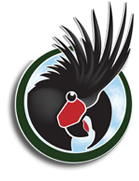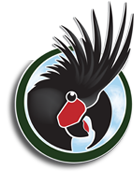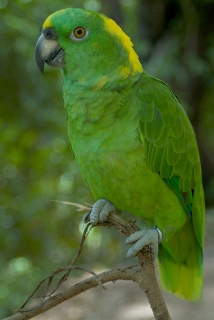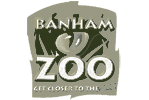Yellow-naped Amazon |
|
|
Also known as: Golden-naped Amazon, Honduras Yellow-naped Amazon (A.a. parvipes)
Photos
View in GalleryDid You Know?
Wild populations of Yellow-naped Amazons have undergone a significant decline in the last decade due to poaching.
Programs & Projects
WPT has worked with numerous partners to help save this species. Learn moreAcademic Research
Related publications: Amazona auropalliataSpecies Profile
Genus: Amazona | Species: auropalliata
Size:
35cm (14in)
Weight:
480-550g (17-19.5oz)
Subspecies including nominate:
three: A.a. auropalliata, A.a. parvipes, A.a. caribaea
Colour Adult:
A. a. auropalliata: Both adults green forehead and crown to area around eyes; yellow patch on lower nape to hindneck that varies with the individual; red on bend of wing absent; yellow on thighs absent. Bill dark grey with pale grey on sides of upper mandible. Eye ring narrow and grey.
A.a. parvipes: Both adults as in auropalliata but yellow on nape more extensive; occasional other yellow markings on forehead; red on bend of wing. Bill pale grey with dark grey markings.
A.a. carbaea: Both adults as in parvipes but more olive/green to underparts; paler in general; grey/horn coloured lower mandible.
Colour Juvenile:
Immatures have no yellow on head or neck; crown washed with blue/green. Bill dark grey. Eye brown.
Call:
Wide variety of squawks, whistles and screams. Also a deep rolling karrow, karr ow.
Listen NowVideo Links:
Video 1More Information:
Content Sources:
CITES
BirdLife International
Cornell Lab of Ornithology/Birds of the World
Parrots of the World, Forshaw, 2010.
Parrots: A Guide to Parrots of the World, Juniper and Parr, 1998.
ML Media Collection Catalogue 74070, Yellow-naped Parrot Amazona auropalliata, Ross, David L., Jr., Guanacaste, Costa Rica, Feb. 27 1988, Cornell Lab of Ornithology. Site
Parrots: Status Survey and Conservation Plan 2000-2004, Snyder, McGowan, Gilardi and Grajal, 2000.
Parrots in Aviculture, Low, 1992.
Lexicon of Parrots, Thomas Arndt.
Psittacine Aviculture, Schubot, Clubb and Clubb, 1992.
Avian Pediatric Seminar Proceedings, various authors, 1988.
Photos
View in GalleryDid You Know?
Wild populations of Yellow-naped Amazons have undergone a significant decline in the last decade due to poaching.
Programs & Projects
WPT has worked with numerous partners to help save this species. Learn moreAcademic Research
Related publications: Amazona auropalliataSpecies Care
Captive Status:
Well known in US; rarer in Europe.
Longevity:
40-60 yrs
Housing:
Aviary or suspended cage, minimum length 3m (9.8 ft).
Diet:
Fruit such as: apple, pear, orange, cactus fruits, pomegranate, banana, forming about 30 percent of diet; fresh vegetables such as: carrot, celery, green peas, beans, fresh corn and green leaves. Cooked/sprouted beans or pulses. Spray millet, mix of small seeds, limited sunflower; complete kibble.
Enrichment:
Bathing using overhead misters or shallow water bowls; foot toys, destructible (non-toxic) wood block or vegetable tanned leather toys, non-destructible (non-toxic plastic) toys, food-finder toys, preening toys, different texture and size hanging perch toys; fir, pine, willow or elder branches, push-and-pull toys (sliding up and down).
Nest Box Size:
12" x 12" x 24" (30.5cm x 30.5cm x 61cm) vertical box.
Clutch Size:
2 or 3
Incubation Time:
26 days
Fledging Age:
11 weeks
Hatch Weight:
14-16g (0.5-0.56 oz)
Peak Weight:
500-600g (17.6-21.1oz)
Weaning Weight:
475-550g (16.75-19.4oz)
Photos
View in GalleryDid You Know?
Wild populations of Yellow-naped Amazons have undergone a significant decline in the last decade due to poaching.
Programs & Projects
WPT has worked with numerous partners to help save this species. Learn moreAcademic Research
Related publications: Amazona auropalliataSpecies Wild Status
World Population:
About 2600
IUCN Red List Status:
Critically Endangered
CITES Listing:
Appendix I
Threat Summary:
The species is threatened by habitat loss and degradation, driven primarily by the expansion of agriculture, and capture for local and international wild bird trade.
Range:
A.a. auropalliata: Pacific slope from Oaxaca, Mexico to NW Costa Rica
A.a. parvipes Mosquitia of Honduras and NE Nicaragua
A.a. caribaea Bay Islands, Honduras
Habitat:
Deciduous or evergreen forest, clearings, savanna woodland, Pinus woodlands on ridges, dense gallery woodland; less commonly in dry thorn forest, mangroves or coastal swamp forest and cultivated areas with scattered trees.
Wild Diet:
Seeds of Cochlospermum, Curatella, figs and ripening Terminalia fruits. Bay Island birds feed on pine cones.
Ecology and Behaviour:
Birds are found in pairs or flocks with larger gatherings at communal roosts and feed areas.
Clutch and Egg Size:
2 to 4 ovate eggs, 37.0 x 30.0mm (1.4 x 1.2 in)
Breeding Season:
February-March; nest is in large tree cavity.
Related Links:
Research: Long-term monitoring of Yellow-naped Amazons in Costa Rica
Research: Range-Wide Population Assessment of the Endangered Yellow-Naped Amazon (Amazona auropalliata)
Research: Yellow-naped Amazon Amazona auropalliata populations are markedly low and rapidly declining in Costa Rica and Nicaragua
Photos
View in GalleryDid You Know?
Wild populations of Yellow-naped Amazons have undergone a significant decline in the last decade due to poaching.
Programs & Projects
WPT has worked with numerous partners to help save this species. Learn moreAcademic Research
Related publications: Amazona auropalliataMembers Only Resources
Please log-in now to find more research, resources and tools.
Not a Member?
Find more great information:
Gain exclusive access to 600+ pages of additional research, seminars and podcasts, specialists to ask your toughest questions, and dozens of other fun resources - when you become a WPT member.
Join Today >>

































